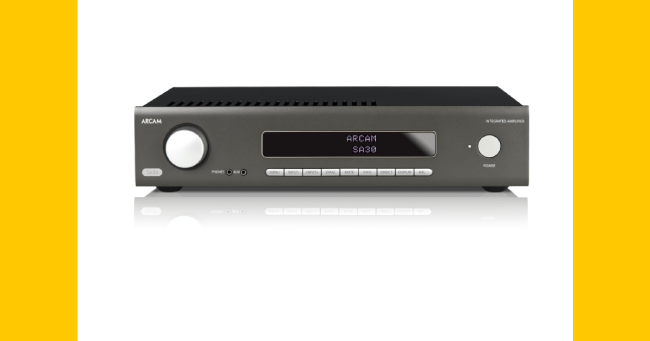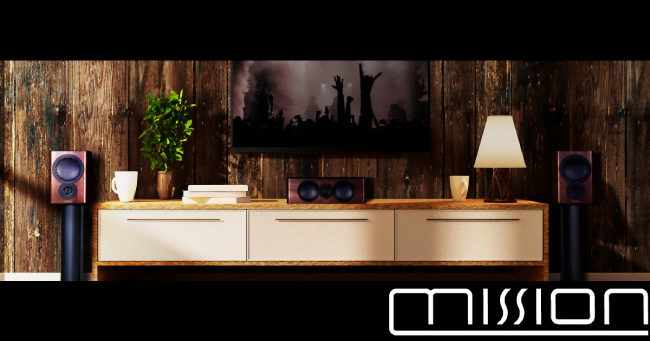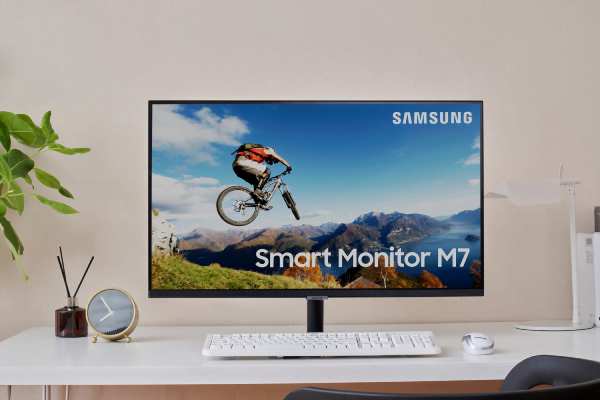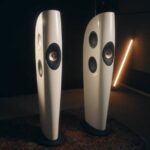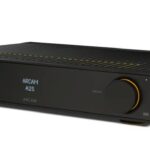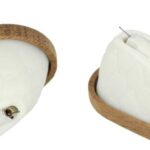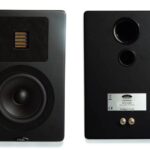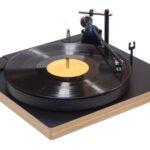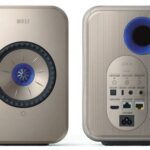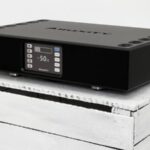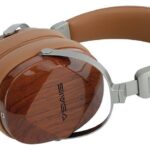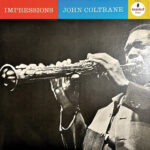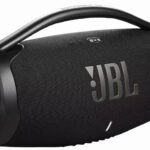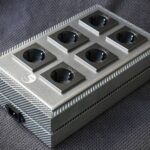Arcam knows better!
And, in this case, Arcam designed a modern integrated amplifier without, however, disproving the classic values through which we know it and for which we love it. And so, the SA30 has many goals. SA30 has to be a good amplifier, to manage all available signals and to sound good. Simple things…
Based on its appearance, the SA30 could very well be part of a range of Arcam amplifiers from previous years. However, the device you see on these pages may resemble a simple Arcam amplifier, but despite all the similarities in design, it’s a complete streaming system, a product to which the user simply needs to add a pair of speakers in order to have a complete and integrated sound system, with significant expansion capabilities with external analogue and digital sources. To this we have to add the amplifier stage G, a circuit having a linear amplifier behaviour with thermal efficiency close to that of the switch. Arcam further enriched the concept of “complete stereo system in a chassis “first introduced through Arcam Music Solo, several years ago.
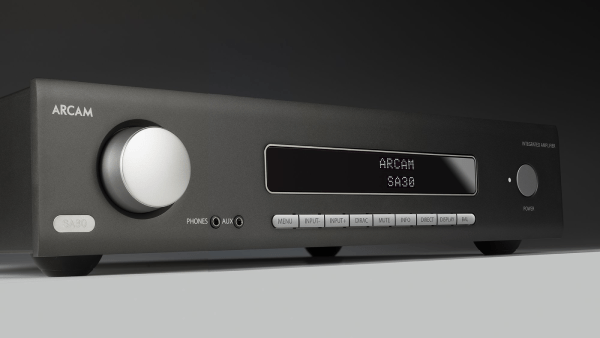
A new … Solo
We appreciated the attitude of Arcam regarding the appearance of the SA30, which has low tones, simple but careful lines and austerity, compared to a facade that “shouts” technology. With a standard full-width chassis and front panel housing a large level slider, a series of simple switches for basic functions and a large and easy-to-read but simple display, the amplifier incorporates the standard Arcam design.
Historically, while Music Solo has centred on CD playback, a perfectly reasonable approach considering when it was introduced, the SA30 is more technologically advanced or – if you prefer – better aligned with current Hi-Fi realities. The amplifier can connect to your home network via Ethernet or Wi-Fi but is also AirPlay compatible to stream music directly from iOS devices to Google Chromecast to playback through devices running Google Home that have access in services such as Spotify, Tidal, Qobuz, Deezer and TuneIn Radio.
The streaming capabilities of the amplifier are complemented by compatibility with the UPnP standard, so that the user has access to high-resolution music from storage devices located on the home network (NAS). To do this, you need to install Arcam MusicLife application, which is available for Android and iOS, on a smartphone or tablet. Alternatively, any UPnP-compatible control application such as mConnect or BubbleUPnP can be used. Roon subscribers will see the SA30 as an Endpoint option and will be able to integrate it into their system, with the relevant firmware upgrade (“coming soon” the company says on its website).
Arcam has many streaming capabilities, but it is the physical inputs that allow the SA30 to function as the core of a multi-source system. Digital connectivity includes two optical and two coaxial inputs, a USB-Type A port for connecting external storage media and an HDMI port that supports eARC. In terms of analogue connections, the device has three pairs of RCA and an additional phono input with compatibility for both MM and MC heads. It is obvious that with such a list of inputs the SA30 ensures that almost any audio device or TV can be connected to it. Also, the user has at his disposal an auxiliary input in the form of TRS / 3.5mm on the front, for a temporary connection of an external source, a headphone output (also TRS 3.5mm) as well as a preamp output for connecting to an external end amplifier. Finally, an RS232 port allows the amplifier to be integrated into a home automation system.
Dirac Support
Arcam has built-in support for Dirac Research’s acoustic space correction technology. As you know, Dirac is designed to modify the performance of the speakers connected to the system and reduce the unwanted tuning created by the room. To make the adjustment, the user inserts the microphone that accompanies the SA30 into the USB port of a computer running the special application “Dirac Live for Arcam” (available for PC and Mac) and located on the same wireless network as the amplifier. All you need to do after that is follow the procedure and the software will process and clean the sound noticeably.
Observers will have already thought, and rightly so, that this function requires an A / D-D / A path for signals from analogue sources, and indeed it does. Arcam solves the problem by offering digital loop bypass (and equalization, of course) with “Analogue Direct” function. The user can create up to three different equalizations and apply them to different inputs.
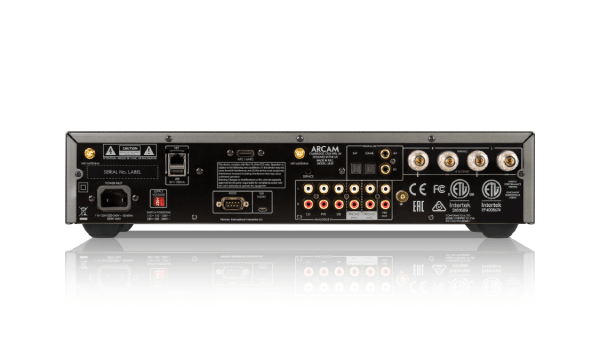
G Class and ThermalTrack.
The SA30 delivers 120W / 8Ω and 220W / 4Ω from a symmetrical power stage based on a pair of On semiconductors (NJL3281D / NJL1302D) of ThermalTrack technology. This technology uses a p-n contact (a diode) built into each transistor as a heat sensor so that real-time polarization control is not required and no separate transistor on the heatsink is required for this purpose. According to On Semiconductor (which has developed the technology) a ThermalTrack power stage can operate at higher calm currents, with polarization closer to the “dangerous area” (beyond which the phenomenon of thermal escape and the destruction of the semiconductors), therefore the passage deformation is reduced as the designer can choose a polarization closer to class A, without significant heat losses and unnecessary risks.
ThermalTrack semiconductors are ideally combined with the operating class G of the stage, which allows the dynamic change of its supply voltage, depending on the signal, in order to minimize losses. This control is done through a MOSFET power, although Arcam does not give more details.
The digital part of the amplifier is based on ESS9038K2M of ESS, 32-bit, Saber technology and the user has access to the different digital filters it offers. The device is MQA compatible.
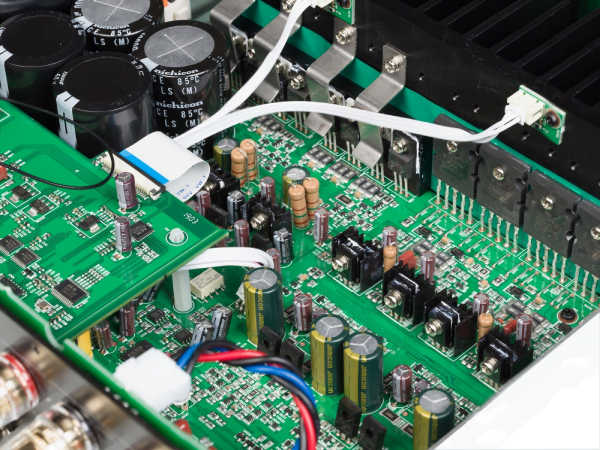
In practice…
The amplifier was as flexible and easy to use as we expected, based on the features we just described. It comfortably implements the ideal of every integrated, that is, to be a control center of all signals, analogue and digital, which will occupy the user with little technical detail (its menu is easy to navigate) and will allow him, simply enjoy his music.
As we ensured the capabilities and flexibility of the amplifier, we had the opportunity to access the collection of high-resolution files, stream from the internet and listen to one or two conventional, local, sources, selections made in a way that very well hid the differences between the various technologies behind each choice. The user does not have to do many things, but one of them is the choice of the digital filter, out of the seven offered by the amplifier (essentially the DAC of ESS). Here the well-known rule applies, that is, to choose what you like best. In our case it was the performance filter, which is also the default of the device.
The SA30 proved to be particularly capable in terms of driving, something we expected based on its power capabilities and G-Class operation, which promises significant dynamic margins. The amplifier has speed and rhythmic flow and has proven to be quite a gifted performer in a wide variety of musical genres. His performance at Johnny Cash – Hurt was full, clear and detailed. The soft, acoustic, sense of “removal” is rich and his narrative voice is dynamic, with all the strange plots that make his narration so genuine and fascinating. Arcam feels very comfortable in vocal performance which is exemplary, with pleasant clarity and subtlety being presented on a large, spacious and tonally uniform sound canvas.
At low frequencies, the SA30 responds willingly offering range, feel and volume. It takes over the wonderful vocals of the Adiemus Songs of Sanctuary, while, at the same time, it forms the necessary sense of spaciousness to maintain the increasingly dense production beautifully understood. It is this range of scale that really gives atmospheric instruments their space. The sound colors sound natural and the SA30 comfortably describes the dimensions and dynamic profile of each recording, transferring the soundscaping decided by the producer to the listening area.
Arcam, with the SA30, has realized the vision of a quality amplifier with significant capabilities for managing digital media (and conventional analogue and digital signals) and not a streamer that happens to have an output stage to hang speakers on it, just to be considered a complete solution. To some it may seem that it deviates to the simple side, without a fancy touch screen, but we evaluate as much more serious advantages the full package of features that offers (along with digital equalization of space) the ease of use and, above all, the very good sound behaviour. For the needs of the user for real Hi-Fi, the SA30 responds maturely, with open sound, speed and clarity, and if you finally like listening to your music, you will not regret it.
Overview
Description: Integrated Amplifier / DAC / Streamer
Power: 2x120W / 8Ω, 2x220W / 4Ω.
Analogue inputs: 3x Line In (RCA), 1x Phono (MM / MC), 1x Aux (TRS 3.5mm).
Digital inputs: 2x Coaxial (RCA), 2x Optical (Toslink).
Streaming: 1x USB-Type A, 1x Ethernet
Wireless Streaming: Wi-Fi, AirPlay compatibility, Chromecast, MQA.
Compatibility: UPnP.
Analogue outputs: 1x Speakers, 1x Headphones (TRS, 3.5mm), 1x Pre. Out (RCA).
Other features: Dirac support, Select digital filters.
Dimensions: 433x100x323, (mm, wxhxd).
Weight: 12kg
Price: € 2,480
info: All About Audio Video, tel .: 213-0998.206, http://www.aaav.gr/, https://www.arcam.co.uk/
Reviewer : Katrakazas Giorgos._ΥΒ

